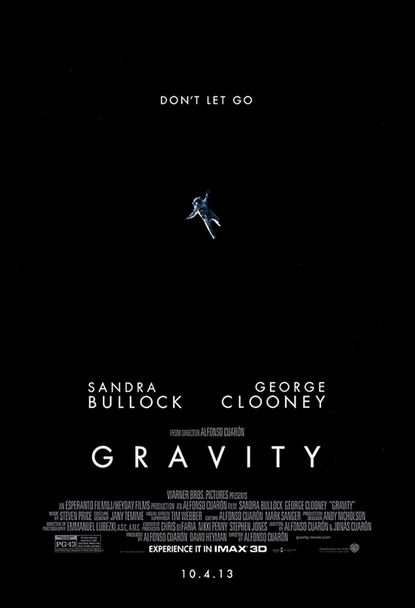No film has ever been so perfectly suited to IMAX 3D as “Gravity.”
 Alsonso Cuaron’s 90-minute non-stop ball of tension is a stunning visual tour de force that is accentuated significantly by the size of the giant IMAX screen, the surround sound, and the depth of 3D created by Prime Focus World.
Alsonso Cuaron’s 90-minute non-stop ball of tension is a stunning visual tour de force that is accentuated significantly by the size of the giant IMAX screen, the surround sound, and the depth of 3D created by Prime Focus World.
So much an integral aspect of the film, “Gravity” should never be seen anywhere except an IMAX 3D theater. In fact, this movie could be the same kind of game-changer for 3D as “Avatar,” advancing the format to the next level. Interestingly, “Avatar” director James Cameron is thanked in the closing credits of “Gravity.”
Cuaron, who seemingly covered every aspect of the film from writing, directing, producing and even editing, grabs your attention immediately with a visually stunning shot of Earth from space that begins an astounding 13-minute non-stop tracking shot. The first sound is a distant radio communication that can be heard so far to the right of the screen that initially it seems like a theater worker has left on his walkie talkie. More radio communication responses then come from the left and center of the screen as we slowly realize we are listening to Houston Mission Control communicating with astronauts around the Space Shuttle working on repairs to the Hubble space telescope. It is only after this impressive audio introduction that we see way off in the distance the tiny embodiment of that first voice, a floating astronaut whose voice we recognize as George Clooney drifting slowly towards the front of the screen. The camera stays on him until he comes so close to the foreground that he nearly pops off the screen before turning and moving back to the spacecraft that soon gets pummeled with debris from a satellite that has been exploded. Thus begins this simple yet powerful story of an astronaut (Sandra Bullock) struggling to overcome seemingly impossible obstacles more alone than can be fathomed.
This is just the beginning of the combination of impressive cinematography and visual effects to demonstrate the incomprehensible expanse of space and the frustrating distance of various objects and sometimes how dangerously close they are. Another seemingly seamless single shot later in the film starts equally far away and moves all the way in to push inside the helmet face mask to the eyes of the floundering and panicked astronaut played by Bullock.
So meticulous and strategic is Cuaron in his exploitation of all that IMAX and 3D has to offer that we even see a tear drop of Bullock slide from her face in a weightless environment and become a little ball of water that floats to the center of the screen to become the full and single focus of the film frame. And yet, it never feels like a gimmick but rather an emphasis of her emotion and her feeling of utter helplessness in this world so far from normality.
The audio and score of Steven Price plays a crucial and effective role as well, with Cuaron staying true to science by leaving all the devastating collisions with spacecraft remaining completely silent and using the underlying score to deliver the entire audio impact, which it does.
Cuaron even manages to create a completely convicing weightless enrvironment for Bullock inside one or more of the space ships, a cinematic feat that is so accomplished and impressive that it harkens to the innovations in “2001: A Space Odyssey” more than 45 years ago.
That trailer and TV preview that has been showing for months in which Bullock and Clooney are seemingly cut off from their space ship and left floating in space (below), is pretty much the entire storyline of the woman-in-peril film. Bullock’s character is left to her own devices and ingenuity in space as one catastrophic incident leads to another each time she devises another heroic act of self-preservation. While those are the awesome challenges for the character in the movie, the audience can sit back and be awed by the presentation of the film itself.
— By Scott Hettrick
